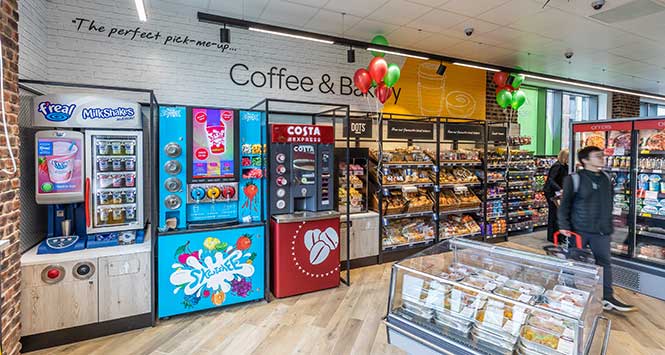Despite several major differences in the market across the water, retailers on a recent study tour to Northern Ireland learnt some simple but valuable lessons that could help boost sales in Scottish stores.
By Antony Begley
If you’ve ever managed to spend any time visiting convenience stores in Ireland, it will have been time well spent, and you’ll be well aware that a visit over the water is many things but never dull.
With that in mind, SLR joined a brief two-day jaunt to Northern Ireland last month to check out four stunning convenience stores in the company of some of Scotland’s top retailers. The trip was organised by Invest Northern Ireland – the hugely proactive agency charged with helping grow sales of Irish food and drink both at home and abroad – and delivered a packed and hugely enjoyable and informative couple of days.
We all know that the Irish market is different, and we also know that Ireland has long been at the forefront of convenience retailing – so it was interesting to see how things had developed in the wake of Covid.
- Spar Mallusk, Newtownabbey
- Spar Mulgrew’s Carryduff
- Nisa Rathfriland, Newry
- Carlisle’s Supervalu, Ballynahinch
- Hinch Distillery, Ballynahinch
- Clandeboye Yoghurt, Bangor
A different market
Firstly, it’s worth addressing some of the major differences between the Scottish market and the Irish one. The biggest of all is the striking lack of supermarkets. During the entire two-day-long trip I don’t think we saw a single supermarket or discounter out the window of the minibus. Not fighting Tesco or Aldi on every corner certainly helps push footfall and sales up because customers shop convenience stores over there the way they shop supermarkets here.
As a result, weekly turnovers in Irish convenience stores can be huge. Do you know any convenience stores in Scotland doing £350k a week?
The knock-on effect is that you also get very big convenience stores. The definition of a ‘convenience store’ has become a bit elastic over there. The traditional definition in Scotland used to be 3,000sq ft or smaller, although you see quite a few that are bigger than that these days. In Ireland, though, they can be much, much bigger. Some of the stores we visited during the trip were what we would call small to mid-sized supermarkets.
The other major issue to note here, and it’s related to the points above, is around alcohol licensing. Long story short, if you don’t have an alcohol licence already, you ain’t getting one unless you have very deep pockets. There is effectively a maximum and limited number of licences issued in Northern Ireland and if you really, really want one, you have to buy it from someone else, someone who already has one and is prepared to sell it. Which makes them extremely valuable. You’ll never end up in the poorhouse if you’re the proud owner of an alcohol licence – and they tend to get handed down through the generations, apparently. It’s more or less a licence to print money.
The workaround solution that many stores adopt, especially newbuilds, is to create a special building next door to your store and lease it to someone with a licence. You benefit from the rent and the footfall the off-licence generates, but that’s as good as you’re going to get.
Spar Mallusk
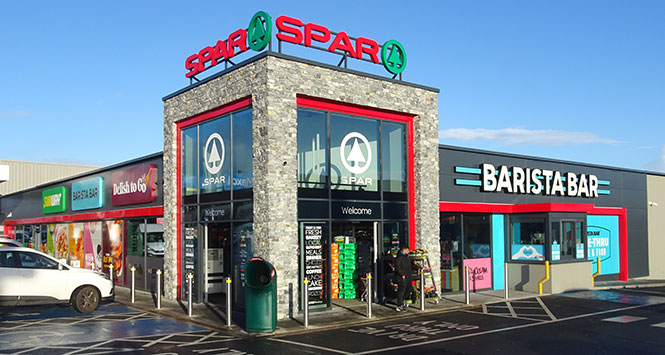
Bearing all that in mind, the first store we visited was Spar Mallusk, the flagship company-owned store of the Henderson Group, the Spar wholesaler for Ireland. Sited just along the road from the company’s main Regional Distribution Centre, the store gets special treatment and is effectively used as the testbed when the Group is trialling new ideas and concepts.
Acquired by Hendersons in 2003 as a 500sq ft store doing £12k a week, it has been completely transformed into a 5,000sq ft stunner of a store thanks to a £2.6m refit – and now does £113k a week. That’s all the more impressive considering the store doesn’t sell alcohol, a Hendersons company policy.
It looks like most modern company-owned Spar stores in Scotland, only a bit bigger. The standout features are the huge food-to-go area, the large in-store coffee bar and the drive-through coffee shop.
Some 28% of the store’s total turnover comes through food to go which equates to around £30k a week – and the margins are nice and juicy, as you’d expect.
The drive-through coffee shop has, apparently, been more effective in driving media coverage than in driving sales although it tells you all you need to know that Hendersons seem disappointed with the fact that the drive through “only does about £3k a week”. It does, however, add to its destination store credentials and brings more customers to what is basically an industrial estate.
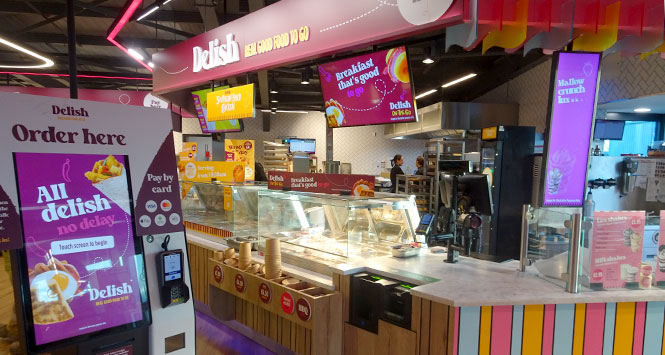
Mulgrews Carryduff
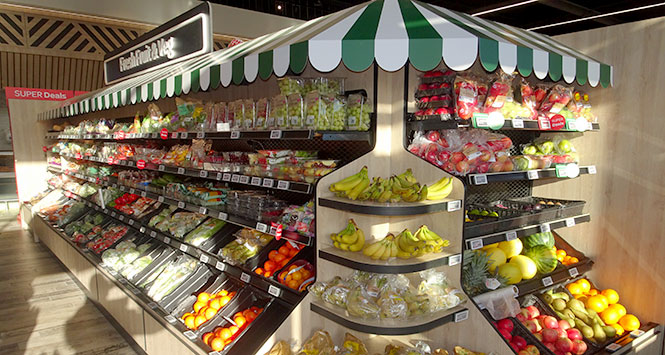
Our next stop was another Spar store, although in Eurospar format, which is essentially the supermarket version of a Spar. Independently owned, it’s a purpose-built monster of a building, and is very impressive in its own way.
A big geometric box, it looks neat, tidy and well presented although, somewhat oddly for a store that big, it almost entirely lacked overhead directional signage. Finding the aisle you’re looking for is a case of wandering along the aisle ends and peering down to see what’s on the shelves.
Again, no alcohol present but an off-licence next door and the standout features, again, were the food-to-go area, the coffee bar and a very tidy butchery counter featuring local meats, as well as a nice bakery section.
Apart from that it was simply a nicely executed store that looks like many good convenience stores you’d see in Scotland, only about four times the size.
Nisa Rathfriland
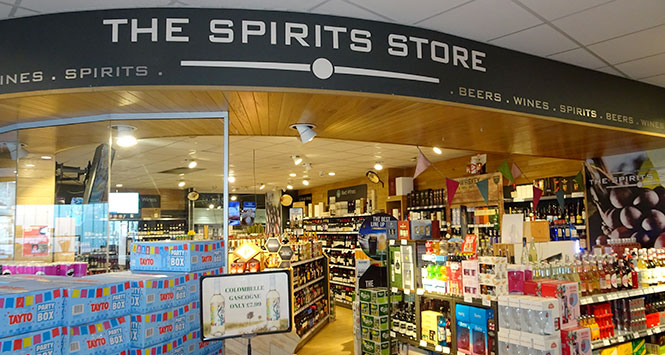
Milestone Rathfriland is a Nisa store, but not a Nisa store as you know it. It’s an Extra format store, which means it’s huge – and it’s huge in every sense. It’s a store that simply couldn’t exist in Scotland, for all sorts of reasons.
To set the scene, consider that according to the most recent census the town of Rathfriland has a population of just 2,472 souls and sits to all intents and purposes in the middle of nowhere. Having absorbed that fact, try to reconcile it in your mind with the fact that the store turns over £350k a week. Now try to imagine what it would be like running a store with 200 staff.
How is that even possible? Because it gets shopped like a supermarket. It’s the only big store for miles so people come from all around the surrounding area. To be fair, it’s less a convenience store than a retail and foodservice complex. There’s a full restaurant and bar upstairs, there’s what looks like a fairly normal smallish supermarket downstairs, there’s even an off-trade section in-store and then there’s the crown jewel: an enormous food-to-go section of the store offering everything you could imagine, hot and cold.
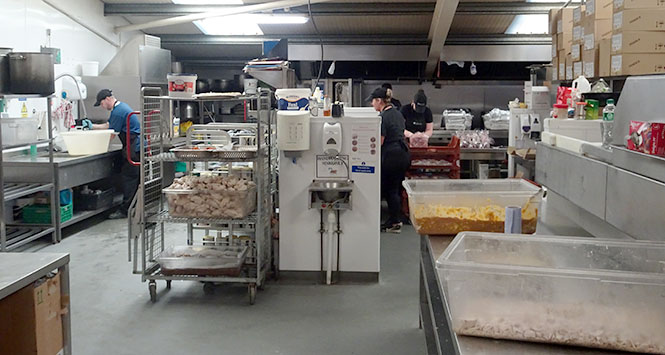
Everything in the food-to-go area is serviced from a vast kitchen upstairs staffed by what looked to be around 30 or 40 people. Virtually everything that’s for sale downstairs is made fresh and from scratch upstairs.
It’s difficult to convey the sheer scale of the operation and it’s difficult to believe that the 20-metre wall of home-made, short-life ready meals sitting in the chillers downstairs will all be sold before they go out of date – but I am assured they will.
As you might expect, the store was a little less pristine than the two stores we had already visited, but the amount of work that must go into running a behemoth like this is almost unimaginable.
With so much of its turnover coming from high-margin food to go, the store operates off of astonishing margins of 35% and above. To put it another way, the business is clearing the best part of £2m a year.
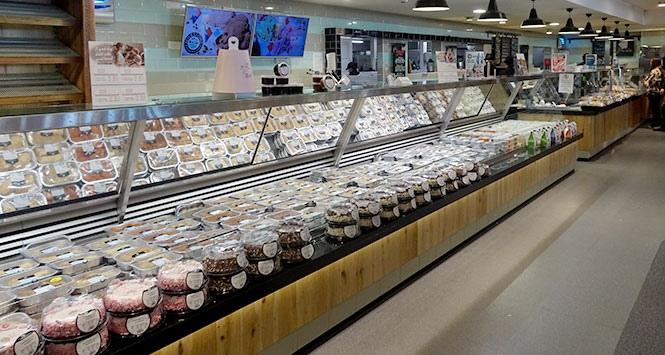
Carlisle’s Supervalu
The last store on the itinerary was Carlisle’s Supervalu, another big and impressive store with the usual high-end food to go, coffee and butchery offer and a separate off licence next door belonging to someone else. The smallest of the four stores we saw, it was the one that looked most familiar to a bunch of Scottish retailers. Looking at it, you’d guess a weekly turnover of maybe £40k. The reality? £180k a week.
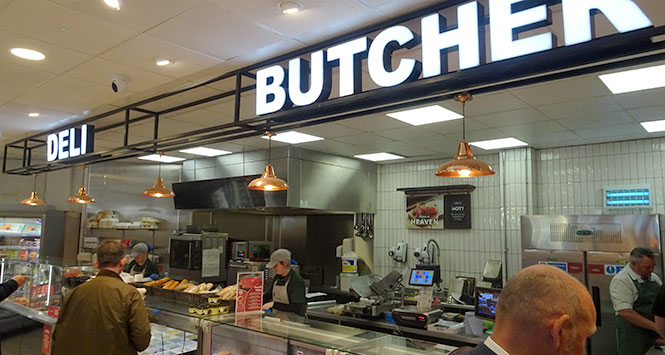
On show
We rounded off the day with a trip to the nearby Hinch Distillery, a fantastically impressive distillery built from scratch by Terry Cross, a man who made a fortune by selling his packaging company and decided to treat himself to a commercial vineyard in France and a newbuild distillery in Ballynahinch, as you do.
A quick trip to Clandeboye Yoghurt completed the tour before a dinner hosted by Invest Northern Ireland that evening, the obligatory pint or two of Guinness and a well-earned kip.
The following day saw the group visit Invest Northern Ireland’s Food & Drink Showcase and find out more about some of the province’s finest food and drink offerings, several of which are now available in Scotland. There’s a thriving food and drink culture in Northern Ireland and there’s a lot we can learn over on this side of the Irish Sea.
It’s also worth having a look at what’s available over there if you’re keen to differentiate your range and give your customers new reasons to visit you.
What did we learn?
Having had a chance to digest the trip, it’s clear that the Irish market is indeed different. Granted, we were only seeing hand-picked impressive stores, but they do it well over there. The biggest advantage they have is the lack of supermarket competition – and there’s not much we can about that over here.
Huge weekly turnovers make everything easier: re-investing, running big teams of staff, riding out tough periods, the lot. But there is still a lot to learn from the Irish experience. Irish retailers have taken their customers on a journey over the years. Yes, it helps that Irish customers are perfectly happy to buy food to go on an epic scale from convenience stores, they’re perfectly happy to buy a broad array of butcher meat and all the rest – but that didn’t happen overnight or by accident.
You’ll notice too that food to go, coffee, good butcher meat are things the supermarkets either don’t do or aren’t very good at.
Many progressive retailers in Scotland have already started on that journey but it might be an idea to start travelling a bit faster. The Covid boom is now a thing of the past and the future is fast approaching. The big takeaway from our Irish store safari is that Irish retailers aren’t doing anything particularly mind-blowing. There was nothing we saw that we’d never seen before, nothing that made us say ‘wow’ – other than the size of the weekly turnovers.
What sets Irish stores apart seems to be simple: fantastic food to go, great coffee and local butchery, all done consistently well. All of that can be replicated over here. It won’t happen quickly and it will take investment, courage and persistence – but consumers can be taken on that same journey in Scotland.




